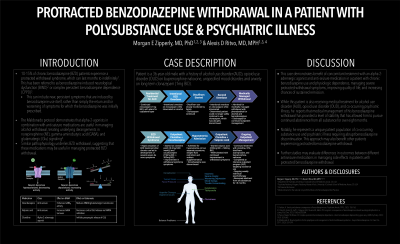Back

(59) Protracted Benzodiazepine Withdrawal in a Psychiatric Patient with Polysubstance Use
Friday, April 25, 2025
9:45 AM – 1:15 PM
Location: Aurora Ballroom Pre-Function, Level 2


Morgan E. Zipperly, MD, PhD
Resident
University of Colorado Anschutz, Colorado
Alexis Ritvo, MD, MPH
Assistant Professor
University of Colorado School of Medicine, Colorado
Presenter(s)
Non-presenting author(s)
Background & Introduction: Previous studies have shown that 15-44% of chronic benzodiazepine users experience moderate to severe withdrawal upon benzodiazepine discontinuation, with increased risk of severe reactions such as seizure, psychosis, and death in patients who abruptly stop the drug [1]. An estimated 10-15% of these patients experience a protracted withdrawal syndrome, that can last from months to indefinitely [2]. Recent literature has suggested referring to this syndrome as benzodiazepine-induced neurological dysfunction (BIND) and/or complex persistent benzodiazepine dependence (CPPD) [3, 4]. These symptoms cause significant patient distress, decreasing quality of life, and increasing the risk that individuals will return to use. There is some evidence that utilizing alpha-2 agonists in conjunction with antiseizure medications can be of therapeutic use in alcohol withdrawal, due to derangements in norepinephrine and glutamatergic signaling [5]. Similar pathophysiology is known to underlie benzodiazepine withdrawal. The present case applied this approach to a patient with protracted benzodiazepine withdrawal following rapid benzodiazepine discontinuation, a syndrome for which there are limited treatments.
Case Description: Patient is a 36-year-old male with a history of alcohol use disorder (AUD), opioid use disorder on buprenorphine-naloxone, unspecified mood disorder, and anxiety on long-term clonazepam (1mg BID). He initially completed residential treatment for AUD, at which time he was continued on clonazepam with plan for gradual outpatient taper in the near future. A few weeks after discharge, he intentionally overdosed on clonazepam while intoxicated on alcohol. In order for the patient to continue to receive his scheduled clonazepam doses, he agreed to daily disulfiram adherence, which was closely monitored by family. He made a second suicide attempt via clonazepam overdose a few months later while intoxicated, and it was decided that he could no longer safely continue on this medication. He was admitted for medically managed withdrawal with phenobarbital for both alcohol and benzodiazepines. With the rapid discontinuation of his clonazepam, he experienced protracted withdrawal symptoms, including insomnia, severe anxiety around other people, worsened depression, facial pressure, problems with balance, hypotension, clumsiness, decreased concentration, mood swings, tunnel vision, and derealization . As an outpatient, he was started on clonidine patch 0.2mg/24hr weekly and oxcarbazepine (150mg BID uptitrated to 300mg BID), which led to significant improvement in sleep, anxiety, and physical discomfort secondary to his protracted withdrawal syndrome. However, he developed hyponatremia requiring hospitalization on two separate occasions, despite fluid restriction and sodium supplementation, necessitating discontinuation of the oxcarbazepine. Given the reported benefit of the combined anti-seizure medication and clonidine therapy, he was started on valproic acid (250mg BID uptitrated to 500mg BID ), which he continues to tolerate well. With this management of his protracted withdrawal symptoms, he has been able to hold steady employment, re-engage with and complete an intensive outpatient program, establish with an individual psychotherapist, and remain abstinent from all substance use for over seven months.
Conclusion & Discussion: This case demonstrates how combination treatment with an alpha-2 adrenergic agonist and an antiseizure medication can benefit patients with chronic benzodiazepine use and physiologic dependence in management of severe protracted withdrawal symptoms, increasing chances of remission and improving patient quality of life. Notably, this patient also meets diagnostic criteria for AUD, OUD, and co-occurring psychiatric illness. While his other conditions were also treated pharmacologically, he reports that medical management of his protracted benzodiazepine withdrawal has provided a level of stability that has allowed him to pursue continued abstinence from all substances, which he has maintained for over seven months. Notably, he represents a unique patient population of co-occurring substance use and psychiatric illness requiring abrupt benzodiazepine discontinuation. This approach may also benefit other patients experiencing protracted benzodiazepine withdrawal. Further studies may evaluate differences in outcomes between different antiseizure medications in managing side effects in patients with protracted benzodiazepine withdrawal.
References: 1) Hood SD, Norman A, Hince DA, Melichar JK, Hulse GK. Benzodiazepine dependence and its treatment with low dose flumazenil. Br J Clin Pharmacol. 2014; 77(2): 285-294.
2) Ashton, H. Toxicity and adverse consequences of benzodiazepine use. Psychiatric Annals. 1995; 25(3): 158-165.
3) Ritvo AD, Foster DE, Huff C, Finlayson AJR, Silvernail B, Martin PR. Long-term consequences of benzodiazepine-induced neurological dysfunction: a survey. PLoS One. 2023; 18(6):e0285584.
4) Peng L, Meeks TW, Blazes CK. Complex persistent benzodiazepine dependence- when benzodiazepine deprescribing goes awry. JAMA Psychiatry. 2022; 79(7): 639-640.
5) Maldonado JR. Novel algorithms for the prophylaxis and management of alcohol withdrawal syndromes – beyond benzodiazepines. Crit Care Clin. 2017; 33(3): 559-599.
Case Description: Patient is a 36-year-old male with a history of alcohol use disorder (AUD), opioid use disorder on buprenorphine-naloxone, unspecified mood disorder, and anxiety on long-term clonazepam (1mg BID). He initially completed residential treatment for AUD, at which time he was continued on clonazepam with plan for gradual outpatient taper in the near future. A few weeks after discharge, he intentionally overdosed on clonazepam while intoxicated on alcohol. In order for the patient to continue to receive his scheduled clonazepam doses, he agreed to daily disulfiram adherence, which was closely monitored by family. He made a second suicide attempt via clonazepam overdose a few months later while intoxicated, and it was decided that he could no longer safely continue on this medication. He was admitted for medically managed withdrawal with phenobarbital for both alcohol and benzodiazepines. With the rapid discontinuation of his clonazepam, he experienced protracted withdrawal symptoms, including insomnia, severe anxiety around other people, worsened depression, facial pressure, problems with balance, hypotension, clumsiness, decreased concentration, mood swings, tunnel vision, and derealization . As an outpatient, he was started on clonidine patch 0.2mg/24hr weekly and oxcarbazepine (150mg BID uptitrated to 300mg BID), which led to significant improvement in sleep, anxiety, and physical discomfort secondary to his protracted withdrawal syndrome. However, he developed hyponatremia requiring hospitalization on two separate occasions, despite fluid restriction and sodium supplementation, necessitating discontinuation of the oxcarbazepine. Given the reported benefit of the combined anti-seizure medication and clonidine therapy, he was started on valproic acid (250mg BID uptitrated to 500mg BID ), which he continues to tolerate well. With this management of his protracted withdrawal symptoms, he has been able to hold steady employment, re-engage with and complete an intensive outpatient program, establish with an individual psychotherapist, and remain abstinent from all substance use for over seven months.
Conclusion & Discussion: This case demonstrates how combination treatment with an alpha-2 adrenergic agonist and an antiseizure medication can benefit patients with chronic benzodiazepine use and physiologic dependence in management of severe protracted withdrawal symptoms, increasing chances of remission and improving patient quality of life. Notably, this patient also meets diagnostic criteria for AUD, OUD, and co-occurring psychiatric illness. While his other conditions were also treated pharmacologically, he reports that medical management of his protracted benzodiazepine withdrawal has provided a level of stability that has allowed him to pursue continued abstinence from all substances, which he has maintained for over seven months. Notably, he represents a unique patient population of co-occurring substance use and psychiatric illness requiring abrupt benzodiazepine discontinuation. This approach may also benefit other patients experiencing protracted benzodiazepine withdrawal. Further studies may evaluate differences in outcomes between different antiseizure medications in managing side effects in patients with protracted benzodiazepine withdrawal.
References: 1) Hood SD, Norman A, Hince DA, Melichar JK, Hulse GK. Benzodiazepine dependence and its treatment with low dose flumazenil. Br J Clin Pharmacol. 2014; 77(2): 285-294.
2) Ashton, H. Toxicity and adverse consequences of benzodiazepine use. Psychiatric Annals. 1995; 25(3): 158-165.
3) Ritvo AD, Foster DE, Huff C, Finlayson AJR, Silvernail B, Martin PR. Long-term consequences of benzodiazepine-induced neurological dysfunction: a survey. PLoS One. 2023; 18(6):e0285584.
4) Peng L, Meeks TW, Blazes CK. Complex persistent benzodiazepine dependence- when benzodiazepine deprescribing goes awry. JAMA Psychiatry. 2022; 79(7): 639-640.
5) Maldonado JR. Novel algorithms for the prophylaxis and management of alcohol withdrawal syndromes – beyond benzodiazepines. Crit Care Clin. 2017; 33(3): 559-599.
Learning Objectives:
- Recognize common symptoms of protracted benzodiazepine withdrawal syndrome, including mood disturbances, heightened anxiety, and physical manifestations.
- Describe the neurochemical changes that arise from chronic benzodiazepine use and how these can be targeted pharmacologically with antiseizure medications and alpha-2 adrenergic agonists for symptom relief.
- Utilize case-based discussion to inform medical management of protracted benzodiazepine withdrawal.
